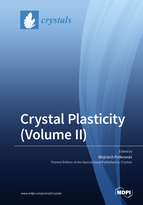Crystal Plasticity (Volume II)
A special issue of Crystals (ISSN 2073-4352). This special issue belongs to the section "Crystalline Metals and Alloys".
Deadline for manuscript submissions: closed (31 August 2022) | Viewed by 59745
Special Issue Editor
Interests: severe plastic deformation; plasticity; materials strengthening; solid/liquid interfacial phenomena; high temperature materials; intermetallics
Special Issues, Collections and Topics in MDPI journals
Special Issue Information
Dear Colleagues,
The extensive response to our call for papers to the first Special Issue volume on “Crystal Plasticity” was very surprising. I am sure that no one expected that 25 excellent articles would be published in such a short amount of time.
You are very welcome to use the free access to read these articles at the link below:
https://0-www-mdpi-com.brum.beds.ac.uk/journal/crystals/special_issues/Crystal_Plasticity.
Our previous efforts have provided us with a completely new collection of original state-of-the-art research papers on both theoretical and experimental aspects of plastic deformation. Indeed, the wide spectrum of submitted papers allowed us to merge the most important topic areas of the crystal plasticity field—i.e., research on the theoretical modelling of dislocation mechanisms and lab-scale validation of materials’ structural/mechanical responses to (semi-)industrial processing. Furthermore, both conventional (e.g., steels, nonferrous alloys) and novel (intermetallics, composites, high entropy alloys) materials were investigated. It was my honor to host well-recognized worldwide authorities as well as young researchers and post-docs taking the “next-step” in their scientific careers. This versatility of contributing authors and topics provides more proof for a high interest of the scientific community in revealing materials’ behaviors at the atomic scale to macroscale under external loadings.
Since we believe that there is still a lot of room for research in the field of crystal plasticity, it is my pleasure to announce the Second Volume of Crystal Plasticity Special Issues. In this, we are going to continue our mission, which is still focused on providing theoretical and experimental research works giving new insights and practical findings in the field of crystal plasticity-related topics. Potential papers include but are not limited to the following subjects, covering the processing of modern functional and structural materials:
- dislocation theory;
- crystal lattice phase transformations and atomic reordering;
- materials strengthening;
- crystallographic texture changes;
- materials processing;
- microstructure evolution.
We are looking forward to your contribution. I wish you all the best in 2021. Take care and stay safe!
Dr. Wojciech Polkowski
Guest Editor
Manuscript Submission Information
Manuscripts should be submitted online at www.mdpi.com by registering and logging in to this website. Once you are registered, click here to go to the submission form. Manuscripts can be submitted until the deadline. All submissions that pass pre-check are peer-reviewed. Accepted papers will be published continuously in the journal (as soon as accepted) and will be listed together on the special issue website. Research articles, review articles as well as short communications are invited. For planned papers, a title and short abstract (about 100 words) can be sent to the Editorial Office for announcement on this website.
Submitted manuscripts should not have been published previously, nor be under consideration for publication elsewhere (except conference proceedings papers). All manuscripts are thoroughly refereed through a single-blind peer-review process. A guide for authors and other relevant information for submission of manuscripts is available on the Instructions for Authors page. Crystals is an international peer-reviewed open access monthly journal published by MDPI.
Please visit the Instructions for Authors page before submitting a manuscript. The Article Processing Charge (APC) for publication in this open access journal is 2600 CHF (Swiss Francs). Submitted papers should be well formatted and use good English. Authors may use MDPI's English editing service prior to publication or during author revisions.
Keywords
- Plasticity
- Crystallographic Texture
- Severe Plastic Deformation
- Cold/hot Plastic Deformation Processing
- Strengthening
- Metals and Alloys
- Intermetallics
Related Special Issues
- Crystal Plasticity (Volume III) in Crystals (14 articles)
- Crystal Plasticity in Crystals (26 articles)






